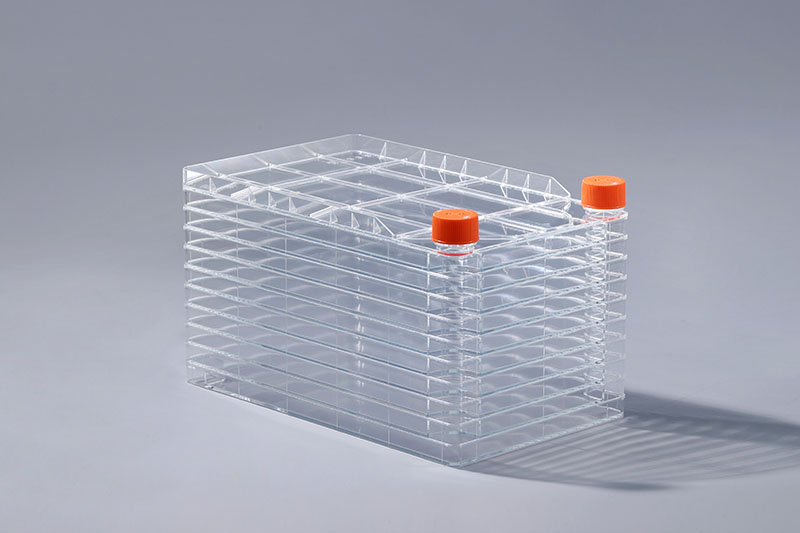là cấu trúc nhiều lớp của vật tư tiêu hao nuôi cấy tế bào, chủ yếu được sử dụng để nuôi cấy tế bào in vitro quy mô lớn. Khi nuôi cấy tế bào, cần có một môi trường cụ thể, và môi trường khí và giá trị pH là một trong những điều kiện quan trọng nhất. ôxy. Oxy tham gia vào chu trình axit tricarboxylic của tế bào để tạo ra năng lượng cho tế bào phát triển, tăng sinh và tổng hợp các thành phần cần thiết khác nhau. Một số tế bào có thể thu được năng lượng thông qua quá trình đường phân trong điều kiện thiếu oxy, nhưng hầu hết các tế bào không thể tồn tại trong điều kiện thiếu oxy. Sức căng oxy thường được duy trì ở điều kiện khí quyển thấp hơn một chút, và nếu áp suất riêng phần của oxy vượt quá lượng oxy trong khí quyển, một số tế bào có thể bị bất lợi. Khi sử dụng phương pháp nuôi cấy mở (nuôi cấy trong đĩa hoặc chai nuôi cấy nắp lỏng hoặc nuôi cấy trên đĩa nuôi cấy), các tế bào thường được đặt trong môi trường khí hỗn hợp gồm 95% không khí và 5% carbon dioxide. Hầu hết các tế bào thích hợp để phát triển ở pH 7,2 ~ 7,4, thấp hơn pH 6,8 hoặc cao hơn pH 7,6 đều có hại cho tế bào, và thậm chí bị thoái hóa hoặc chết. Các tế bào khác nhau có các yêu cầu khác nhau về giá trị pH. Nói chung, tế bào nuôi cấy sơ cấp có khả năng chịu giá trị pH kiềm kém hơn khả năng chịu axit, và môi trường axit có lợi hơn cho sự phát triển của tế bào hơn là môi trường kiềm. Để duy trì giá trị pH không đổi của môi trường nuôi cấy, người ta thường sử dụng phương pháp thêm chất đệm như photphat vào môi trường. Carbon dioxide không chỉ là chất chuyển hóa của tế bào, mà còn là thành phần thiết yếu cho sự phát triển của tế bào, và có liên quan đến việc duy trì độ pH của môi trường nuôi cấy. Trong trường hợp nồng độ khí cacbonic thấp trong môi trường kín, tế bào rất dễ phát triển; nói chung nó không thể thấp hơn 1%, nếu không các tế bào sẽ bị hư hỏng. Nếu môi trường nuôi cấy mở được đặt trong môi trường khí có chứa 5% carbon dioxide thì nên làm.
Với sự phát triển nhanh chóng của lĩnh vực khoa học sự sống, các nhà máy sản xuất tế bào đang được ứng dụng vào nhiều hơn lĩnh vực. Nhưng dù sử dụng trong lĩnh vực nào thì môi trường khí và giá trị pH trong quá trình nuôi cấy tế bào vẫn là một trong những điều kiện quan trọng để tế bào phát triển.
Carbon dioxide is not only a metabolite of cells, but also an essential component for cell growth, and is related to maintaining the pH of the culture medium. In the case of low carbon dioxide concentration in a closed environment, cells are easy to grow; generally it cannot be lower than 1%, otherwise the cells will be damaged. If the open culture is placed in a gas environment containing 5% carbon dioxide, it is advisable.
Most cells are suitable for growth at pH 7.2~7.4, lower than pH 6.8 or higher than pH 7.6 are harmful to cells, and even degenerate or die. Different cells have different requirements for pH value. Generally, primary culture cells are less tolerant to alkaline pH value than acid tolerance, and an acidic environment is more beneficial to cell growth than an alkaline environment. In order to maintain a constant pH value of the culture environment, a method of adding a buffer such as phosphate to the medium is often used.
With the rapid development of the field of life science, cell factories are being applied to more fields. But no matter which field it is used in, the gas environment and pH value during cell culture are still one of the important conditions for cell growth.
The FAI climbed 5.9 percent year-on-year in the first 11 months of 2018, quickening from the 5.7-percent growth in Jan-Oct, the National Bureau of Statistics (NBS) said Friday in an online statement.
The key indicator of investment, dubbed a major growth driver, hit the bottom in August and has since started to rebound steadily.
In the face of emerging economic challenges home and abroad, China has stepped up efforts to stabilize investment, in particular rolling out measures to motivate private investors and channel funds into infrastructure.
Friday's data showed private investment, accounting for more than 60 percent of the total FAI, expanded by a brisk 8.7 percent.
NBS spokesperson Mao Shengyong said funds into weak economic links registered rapid increases as investment in environmental protection and agriculture jumped 42 percent and 12.5 percent respectively, much faster than the average.
In breakdown, investment in high-tech and equipment manufacturing remained vigorous with 16.1-percent and 11.6-percent increases respectively in the first 11 months. Infrastructure investment gained 3.7 percent, staying flat. Investment in property development rose 9.7 percent, also unchanged.
 English
English



















































